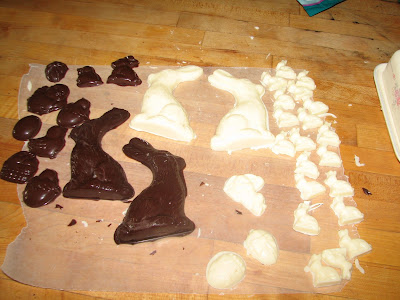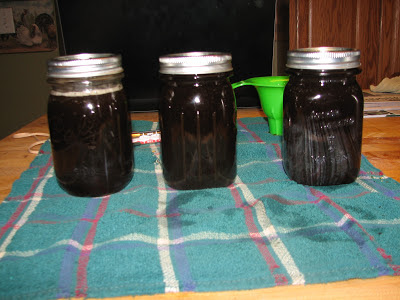This homesteading thing, that is.
It was in me all along, I think. Being outside, just observing nature, getting dirty, that was what I liked. I can't say how many bees I stepped on--and consequently got stung by--growing up (running barefoot), or how many hours I spent crouched next to an ant hill watching the little worker ants bringing grains of soil up out of their tunnels, or how I managed to read a book while 20 foot up a tree that was swaying in the wind. But that was what I liked. Not tv, not being indoors, not necessarily being around people, but being outside in all kinds of weather.
My career goals weren't quite in line with the 'girls can do anything' mantra that was repeated to me by my mother and my female teachers; that generation who had fought to liberate us females from the drudgery of a lifetime of changing diapers, cooking, housework. They were thinking corporate climber, doctor, politician, scientist, astronaut, nobel peace prize winner. What I filled out the career interest category on my high school aptitude tests with was "Farmer". Definitely not the high-powered career I had always been encouraged toward. I wrote "Farmer" because being a wife, a mom and self-employed while living on a farm (my three goals in life) was not listed in the career options. I was pretty good with academics (had been in the Gifted & Talented Program until budget cuts did away with it in middle school) and my aptitude tests came back suggesting I should go into environmental engineering, or accounting, or veterinary medicine, because, according to the experts grading the tests, I was "overqualified for farm work".
How ironic that twenty-some years later, the best and brightest young women in our high schools are being encouraged to go into farming, especially the sustainable kind.
I do know when my homesteading endeavors took off though, even if I can't lay my finger on their exact origins. They took off the day my second child lay in a hospital bed, on oxygen, with a diagnosis of severe asthma. That day, I was told losing that particular child to an early death was not out of the realm of possibility. A very sobering thing to hear.
This poor child had started life just as big and strong and healthy as his elder brother had. But within six weeks, eczema was making itself known on his body. Within a few months, he was beginning the worse colic phase I have ever known, in the 21 years before or the 19 years since his infancy. It lasted well past his first birthday. At six months of age, he had fallen from the top 25 percent of the growth charts to the bottom 25 percent. He seemed to be barely growing in comparison to how his brother had grown in the first year of life. By nine months, his pediatrician had referred him to a dermatologist, and that dermatologist told me that my little boy had "the worst eczema I've ever seen. Your son will most likely never have normal skin." Crushing news for a mother. He had ointments that contained steroids, and tar, and when those failed to clear up his eczema flare ups, the dermatologist talked about ultraviolet light treatments. DH and I refused to subject our infant to what basically was a tanning bed. If we were supposed to use sunblock on our children to keep them from developing skin cancer in their adulthoods, how in the world could UV treatment be good for such a little guy?
At eighteen months, DS2 started seeing a different dermatologist (we had moved about two hours away, thus needed to find a new skin doctor for him). This dermatologist was old, he'd been practicing for 35 years by the time DS2 became his patient. Not only did he have decades of experience, he himself had eczema, and had made it his pet project. Gone were the strong suggestions of UV treatments. Gone were the tar ointments. Instead, this doctor talked about management from the inside: through nutrition, and through avoiding things that could cause eczema flare ups. I heard, for the first time, about the Feingold diet, and about preservatives in food. I heard about artificial flavorings, and colorants. I heard about perfumes and dyes and chemicals in our clothing, toiletries, and environment.
I heard about that stuff, and I did follow a little bit, especially the perfumes and dyes in the things that touched his skin, but I didn't yet make a drastic change in our lifestyle to avoid every one of those irritants.
Then, exactly one day after DS2's fourth birthday (at which point he was not even 3 foot tall--a height DS1 had obtained around his second birthday--and weighed only 30 pounds), he woke up with his first ever asthma attack. He couldn't get out of bed, couldn't walk, couldn't even talk he was so short of breath. The night before, he'd been his normal cheerful, talkative, active self, enjoying his birthday party with all it's cake and ice cream and presents and relatives. Now, however, he was pale, with dark rings around his worried eyes, and you could see every bone in his body as he struggled to breathe.
I carried him to the van, rushed the other two kids into it (I was about 2 months pregnant for baby #4--DD2--at the time), and drove to the family doctor. There, the staff took one look at him and called for an ambulance immediately. He was started on oxygen, given epinephrine and steroids,and taken to the biggest hospital nearby.
Where he stayed for three days while the hospital staff got his lungs under control, his blood oxygen level back to normal (up from the initial reading of 85% in the ambulance), and DH and I were repeatedly quizzed on his health history and if he'd ever shown any signs of asthma in the past. Before being released from the hospital, DS2 was referred to an allergist, and an appointment made for extensive allergy testing the following week. He came home with a nebulizer (we called it his "breathing machine"), an albuterol inhaler, and lots of medications.
That was what really kicked off my homesteading journey. After the allergy test came back (mild egg allergy, but no other food allergies; extensive 'environmental' allergies like every animal under the sun, molds, mites, dust, pollens, you name it), DS2 was started on allergy shots. He also in that time frame had another visit with his dermatologist (who had, by then, made alot of progress on keeping DS2's skin under control without strong prescription lotions). The dermatologist and I talked about the asthma, and the genetic link between eczema and asthma. Unfortunately soon after that appointment, the dermatologist suffered a stroke and had to retire from practice. I was on my own in the battle for conquering DS2's eczema, as the replacement dermatologist poo-poo'ed our holistic way of doing things and insisted I return to treating DS2 with steroids and other strong pharmaceutical things.
So, without a mentor to point me in the direction of exploring this asthma/eczema/lifestyle link, I struck out on my own. I read about asthma. I read about eczema. I researched. I experimented with changes in our home. Out went not just the dreaded BHT and BHQ that the dermatologist had warned me about, but out also went artificial sweeteners, which I had learned were often a culprit in creating an asthma attack. DS2 was taught to ask "is it sugar free?" of any treat offered to him by anyone other than me (especially well intentioned grandmothers and school moms who were on the 'healthy and sugar free' bandwagon) and to politely refuse any sweet treat not made with 'real sugar'. Artificial colors, too were gone. No more orange, or blue, or green, or red breakfast cereal. Our breakfast cereal, when I bought it (I no longer do), was beige. The color of the flours it had been made from.
I cooked even more from scratch. I started to garden, growing our veggies organically. Most of our meat by then was raised by Mother-in-Law, or hunted. When DD2 was old enough to start eating solid foods, her baby food didn't come from the store. I cooked it. Pureed venison was one of her first meats.
We banned perfumes and scented lotions from our home entirely, not just from touching DS2's skin. Scented candles were also banned. Nothing smelly that wasn't naturally so (like onions and garlic, lol). The time hallowed household cleaners got chucked in the trash, and in their place, baking soda, vinegar and hot water were installed.
Over time, and with more 'radical weirdo' (for the late 1990's) changes in our home and diet, DS2 got better. His asthma never again came up so rapidly that he ended up in the hospital. In fact, it became confined to just two months of the year: the spring pollen and mold season. His skin, too, was getting better. It looked, yes, it looked almost as normal as the skin of our other three children.
Then DH and I noticed that the other kids, too, were looking more healthy. Not just looking, but
were more healthy. Gone was DS1's yearly bout of bronchitis in the winter. DD2, our baby, was healthier than any of her siblings had been in their infancy and toddler hood. In fact, by the time DD2 went to the doctor for her pre-kindergarten physical, the doctor didn't even have her in his computer system anymore because she hadn't had a need to see him (no illnesses) since her last round of selective immunizations before her second birthday. When flu and strep went through the elementary school, not one of my children had a sick day that year. Kind of a strange feeling when the only kids in the school with perfect attendance for an entire school year live in your house, and you know you feed them differently than the way their schoolmates are fed. Strange, but affirmative.
From there on out, DH and I were convinced that simple and homegrown was the way to go. Since he was busy being the breadwinner, I was elected the homesteader. And that is how this little place here, really got started.
As for DS2 and his health problems? At age 7, he won the 50 meter dash for his age group in the school's field day. At age 10, he began playing soccer, which requires lots of running. In high school, he not only spent four years on the varsity soccer team, he spent four years running track. This from a little boy whom DH and I were told had a high probability of not living to adulthood because of the severity of his asthma. And his eczema? Well, he gets a little flaky if he doesn't put lotion on every day--regular old colloidal oatmeal lotion, not steroids, no prescriptions. But other than that, he's a handsome devil whose skin looks just like every other cute college guy's skin. He is very conscious of what he puts on, and in, his body. All those environmentally conscious sustainable farming type college girls think he's awesome. ;0)

















































